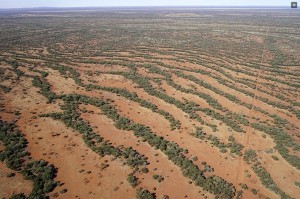Climate change and the prospect of more frequent and intense climate extremes, such as prolonged droughts, threaten many services that plant communities provide to humans. The concern is a community structure change, involving the displacement of key functional species and a decline in species diversity. The high complexity of ecosystems, reflected in part by their hierarchy of organizational levels, hampers attempts to disentangle ecosystem responses to climate extremes that involve mechanisms operating at different organizational levels.
Ben-Gurion University of the Negev scientists found a positive aspect of that complexity; it holds promise for mitigating adverse effects of prolonged droughts by providing diverse pathways of ecosystem response. They developed and studied a mathematical model that captures a response mechanism operating at the population level – self-organization of plants in spatial patterns (see figure below), and a response mechanism operating at the community level – community shift from species investing in growth to species investing in tolerating water stress.
Using this model to study the interplay between the two mechanisms, Prof. Ehud Meron, of The Jacob Blaustein Institutes for Desert Research, his postdoctoral fellows Dr. Bidesh Bera and Dr. Jamie Bennett, and his former PhD student, Dr. Omer Tzuk uncovered three surprising insights: (1) spatial self-organization acts to reverse community-structure changes induced by water stress, (2) it buffers the impact of further stress, and (3) it generates multi-stability of alternative ecosystem states and suggests new forms of ecosystem management that integrate the need for provisioning ecosystem services with the need to conserve community structure.
“These insights highlight the need to consider essential aspects of ecosystem complexity – spatial self-organization in this case – when addressing possible responses of ecosystems to climate extremes and devising management forms for ecosystems at risk,” says Prof. Meron “We focused on drylands, but spatial self-organization also occurs in wetlands, such as hydric peat bogs and salt marshes, or undersea in seagrass meadows, and similar conclusions may hold for these systems as well.”
The research was supported by the Israel Science Foundation (grant no. 1053/17).
Prof. Meron is the incumbent of the Phyllis and Kurt Kilstock Chair in Environmental Physics of Arid Zones.
Ben-Gurion University of the Negev (BGU) is the fastest growing research university in Israel. With 20,000 students, 6,000 staff and faculty members, and three campuses in Beer-Sheva, Sde Boker and Eilat, BGU is an agent of change, fulfilling the vision of David Ben-Gurion, Israel’s legendary first prime minister, who envisaged the future of Israel emerging from the Negev.
The University is at the heart of Beer-Sheva’s transformation into an innovation district, where leading multinational corporations and start-ups eagerly leverage BGU’s expertise to generate innovative R&D.
BGU effects change, locally, regionally and internationally. With faculties in Engineering Sciences; Health Sciences; Natural Sciences; Humanities and Social Sciences; Business and Management; and Desert Studies, the University is a recognized national and global leader in many fields, actively encouraging multi-disciplinary collaborations with government and industry, and nurturing entrepreneurship and innovation in all its forms.
BGU is also a university with a conscience, active both on the frontiers of science and in the community. Over a third of our students participate in one of the world’s most developed community action programs.
Published in eLife late last month



















